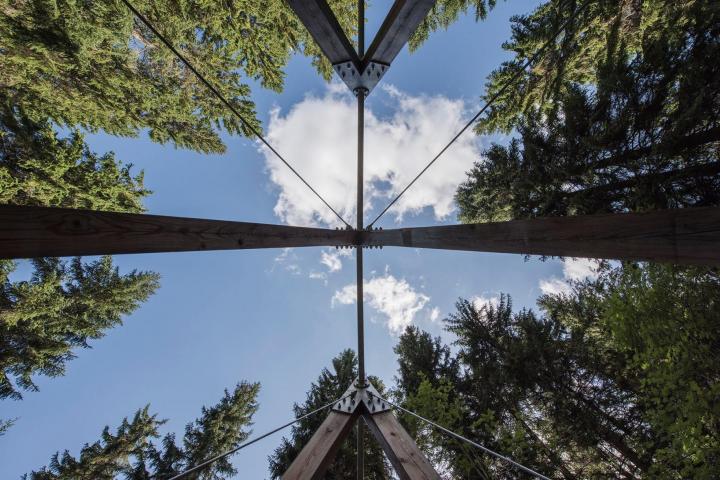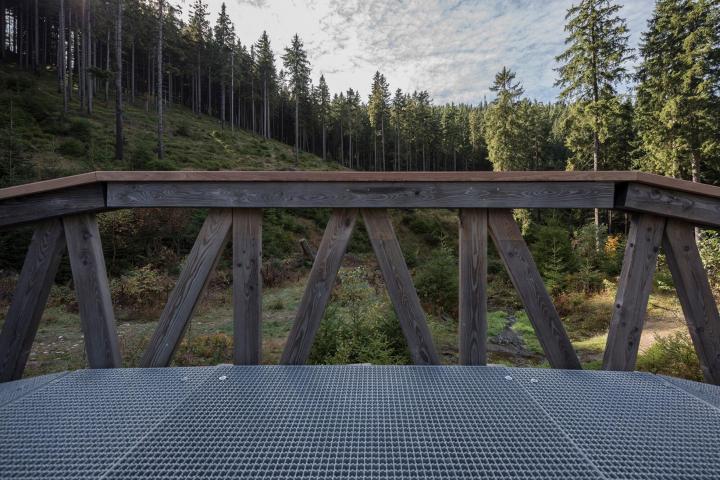Publication date:
2019/12/06

Two footbridges with benches on Klínová cesta, construction in the form of a truss over the Bear Creek, a triangular footbridge at Hrnčířské Bo udy and a footbridge for cars and cars in Eliška's valley have been available to visitors of the highest Czech mountains since autumn. They were created thanks to the cooperation of the Faculty of Architecture of the Czech Technical University in Prague with the Krkonoše National Park Administration. A total of 30 students from 5 studios of the Institute of Design II participated in the project.
Working on the territory of the Krkonoše National Park posed a number of challenges to students. They had to devise the footbridges in such a way that they could be dismantled and individual elements could be easily handled even without the use of heavy equipment. Some footbridges are located in avalanche areas where their shape and design must withstand large amounts of snow.
Extreme climatic conditions were crucial for material selection. Therefore, the authors of the footbridge over the Hluboká ditch chose the weather-resistant Corten steel and took a welding course to be able to make walk-on grids themselves. Or they designed more complicated parts of steel when, due to the tradition and character of the place, they did not want to give up the wood belonging to the mountains.
Students started to work on the designs in October 2018, then the construction was carried out with the assistance of professionals, engineers and craftsmen, in January 2018 directly in front of the Faculty of Architecture of the Czech Technical University. In July 2019, KRNAP workers installed footbridges to the final places in the mountains. Before installation, they had to remove the original bridges and modify the terrain. The most difficult preparation was at Renner's stream in Eliška's valley, where it was necessary to repair and erect pillars from the local stone into which the footbridge is anchored. On the other hand, the footbridge itself could be brought here and mounted by a crane. Other footbridges in remote locations were transported to the sites manually on the chassis, yet their installation did not take more than 14 days.
The footbridge on the Medvědí creek is located on a hiking, cycling and cross-country trail directly connecting the east with the west part of the Krkonoše mountains. A simple but distinctive wooden lattice structure spans the valley of the Medvědí pit at a height of 1,020 meters above sea level.
Another footbridge, across the Černá ditch, follows the terrain in the avalanche area and naturally turns in the direction of the trail. The two main beams overcome the 7 meter span and naturally link two different height levels. There is a bench along the upper line of the external beam, overlooking the valley. The cedar wood, from which the footbridge is made, smells exotic even almost two years after completion.
The minimum number of resting places and unique views of the valley are behind the concept of the footbridge over the Hluboká ditch. The footbridge is located on the slope of Stoh, at a place where the Hluboká ditch is overcome by a blue hiking trail leading from Špindlerův Mlýn to Klínové Boudy. Its shape is based on the terrain configuration of the trough and the movement of visitors. Part of the footbridge is a bench that turns towards the valley.
The footbridge over the Renner brook in the Eliška Valley near Renner's chalets is designed to be passable by car. In principle, robust and heavy construction elements were avoided by assembling the load-bearing structure from multiple shorter timber beams that could be handled better. The proposal also limits large areas where water could adhere. Authors chose traditional local wood material, the bonds are from steel due to their durability.
The footbridge over Čistá near Hrnčířské Boudy chalets is located in a narrow ravine and in a sharp turn. Its spatially distinctive form consists of seven wooden regular triangles that are connected by steel elements and float thanks to the steel rods.A "tread" of the footbridge made of planks is inserted in this basic design box. Anyone who walks through the footbridge can explore every detail and touch the individual elements.
Photo: Martin Čeněk

